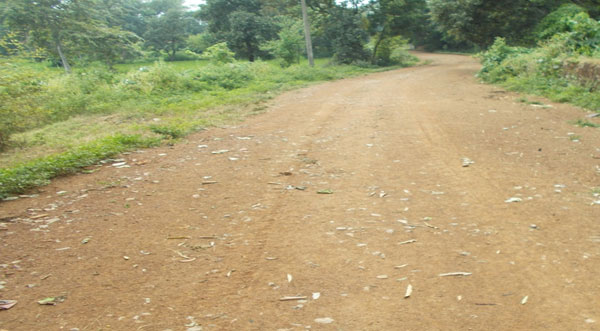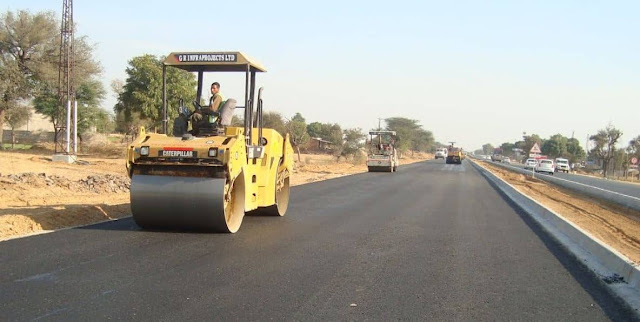Water Bound Macadam Road
Water Bound Macadam Road
The Water Bound Macadam Road is constructed in very ancient days. The roads having their wearing surface consisting of clean, crushed aggregates, mechanically interlocked by rolling and bound together with a filler material and water, laid on a prepared base course is called Water Bound Macadam road. This is constructed as a village road serves as a base for bituminous roads. In most of the roads projects, in the first phase, Water Bound Macadam Road is constructed and when the funds are available, the surfacing is done with the premix carpet bituminous macadam or cement concrete. So a Water Bound Macadam Road is considered the mother of all types of road construction.
Construction Of Water Bound Macadam Road
Water Bound Macadam Road is known after John Macadam, Surveyor General of Road in England in 1827, who was the first to introduce this particular road. In the present day, the term macadam means the pavement base course constructed by broken aggregates that are interlocked mechanically by rolling and voids filled with screening and binding materials with the help of water. The Water Bound Macadam Road is used as a sub-base, base course, or surface course. The thickness of each layer ranges from 7.5 cm to 10 cm depending on the size of aggregates used. To prolong the life of the Water Bound Macadam Road, bituminous surfacing is provided. Construction procedure involves preparation of foundation, provision of literal confinement, spreading of coarse aggregates, rolling, application of screening, sprinkling and grouting, application of binding material, and setting and drying.
After completing the earthwork in the embankment and cutting, the formation level is prepared. The sub-grade is generally in the form of a trench a thickness equal to the thickness of finished pavement. The sub-grade is prepared according to the chamber and grade of the road. It is then thoroughly compacted with a road roller of weight not less than 8 tones. Before rolling, water is sprinkled on the sub-grade. Any low pot, if developed during rolling should be rectified and the surface brought to the required grade. If the soil is clayey, a layer of granular material like natural sand, mourn, gravel, literate, or Kantar should be spread with 10 to 15 cm thickness. Earthen Krebs along the road edge of 15 cm depth are constructed to hold the road materials in the proper position.
Water Bound Macadam Road is done in the following stages
Preparation of Sub-grade
After completing the earthwork in the embankment and cutting, the formation level is prepared. The sub-grade is generally in the form of a trench a thickness equal to the thickness of finished pavement. The sub-grade is prepared according to the chamber and grade of the road. It is then thoroughly compacted with a road roller of weight not less than 8 tones. Before rolling, water is sprinkled on the sub-grade. Any low pot, if developed during rolling should be rectified and the surface brought to the required grade. If the soil is clayey, a layer of granular material like natural sand, mourn, gravel, literate, or Kantar should be spread with 10 to 15 cm thickness. Earthen Krebs along the road edge of 15 cm depth are constructed to hold the road materials in the proper position.
Preparation of the Base Course of Foundation
This consists of 12 to 18 cm size boulders or broken pieces of stones, over burnt bricks, or brick soling. Care should be taken to keep minimum possible voids in the hand packing of boulders. Voids are filled with small pieces of stones. The width of this course is kept 60 cm wider than the pavement width of the road. The surface is then compacted with 10 tones roller as the base course is laid with boulders.
Advantage of Water Bound Macadam Road
1) Water Bound Macadam Road is superior in quality because the materials are carefully graded and the resulting mass is almost void less compacted mass.2) The interlocking of aggregate particles imparts adequate strength to the materials selected for filling the voids. These ensure non-entry of the plastic materials of the sub-grade into the voids.
3) Water Bound Macadam Road is less costly as compared to a bituminous base course.
The disadvantage of Water Bound Macadam Road
1)The stone pieces used in Water Bound Macadam Road are keyed together utilizing sand and clay and no other cementing material is used. The binding effects of sand and clay depend upon the pressure and moisture.2) When a fast-moving vehicle passes over a Water Bound Macadam Road, the slurry of sand and clay is sucked out by pneumatic wheel tires, the stone pieces get disturbed and finally, the road surface is disintegrated. Due to this, the Water Bound Macadam Road is not suitable for fast-moving vehicles with pneumatic wheels.
3) These roads are only suitable for moving iron wheeled traffic such as ton gas, bullock carts, etc.
4) Constant use of the road by iron wheels, the road mental gets crushed. Considering these factors, it may be inferred that a Water Bound Macadam Road survives only for a short time.







Thanks for shearing a good knowledage "W.B.M. Roads"
ReplyDeleteAmazing post, thanks for sharing it. WBM Road
ReplyDeletetypes of arc : Welding has limitless possibilities depending on the kind of welding you are looking to learn. There are four main types of welding
ReplyDelete